Clash of Titans
Games featuring a future Hall of Fame coach on each sideline.
January 1, 1966: Cotton Bowl - Arkansas vs LSU
Frank Broyles vs Charlie McClendon
Coach Frank Broyles's eighth Arkansas team completed its second straight undefeated season to run their winning streak to 22 games. After leading the nation in scoring defense in 1964, the '65 Razorbacks boasted the top scoring offense in the nation (32.4 ppg). They finished second to undefeated Michigan State in both the Associated Press and United Press International Coaches regular season polls.
Despite a disappointing 7-3 record, the Tigers received a bid to play Arkansas in the Cotton Bowl. Snakebitten coach Charlie McClendon had lost his starting quarterback four seasons in a row. So he gave talented sophomore Nelson Stokley playing time so that he could take over should senior Pat Screen go down again.
The Tigers began the up and down season #8 in the Associated Press poll and rose to #5 after victories over Texas A&M and Rice. But a loss at Florida dropped them out of the rankings before they moved back into the Top Ten with three straight victories. Then McClendon's quarterback plan took an unexpected twist when Stokley suffered a knee injury in the 23-0 loss to Ole Miss that ended LSU's second stay in the AP Top 10. The season cratered the following week with a 31-7 home loss to #5 Alabama.
Screen rallied the troops for a 37-20 triumph over Mississippi State and the third 62-0 rout of Tulane. LSU Athletic Director Jim Corbett, helped by SEC Commissioner Bernie Moore, LSU's coach for its first five bowl games, brokered an invitation to the Cotton Bowl for the 7-3 Tigers.

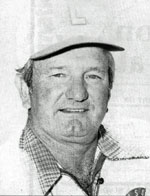
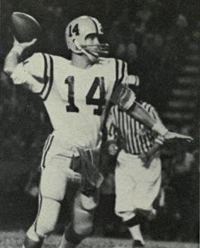
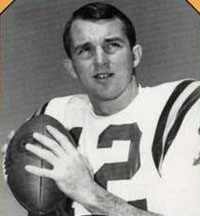
L-R: Frank Broyles, Charlie McClendon, Nelson Stokley, Pat Screen
Arkansas and Cotton Bowl fans and media complained that LSU wasn't worthy to play in the Cotton Bowl. Beating a three-loss team would not help the Razorbacks climb to the top spot in the final AP poll, which was postponed until after the bowl games for the first time. But Coach Broyles knew the Tigers were a formidable foe.
"Charley McClendon's sitting behind a rock with a great football team. Don't let that 7-3 record fool you."
But his admonition fell on deaf ears, as several incidents after the Tigers arrived in Dallas illustrated. The Hog faithful mocked the Tigers by yelling "LS-Who?" One arrogant writer asked McClendon, "How bad do you expect your team to lose?" As the LSU players walked through the lobby of their hotel, a woman wearing a red Porker hat shouted, "Look. They're going to show up for the game."
During the weeks of bowl preparation, Coach Mac dressed his scout squad in red jerseys all bearing the number 23 as a constant reminder of his team's goal of preventing the Razorbacks' 23rd consecutive victory. Mac privately felt confident that his offense would be able to run on the Arkansas defense, which surrendered more than 400y in a tight 27-24 win over Texas.
A record 76,200 spectators gathered for a rematch of the 1947 Cotton Bowl on a day so overcast the stadium lights were turned on by the 1 pm kickoff.
The Razorbacks were eight- to 10-point favorites.
Razorbacks Score First
After Arkansas went three-and-out with the opening kickoff, LSU took possession at its 20. Pat Screen started at quarterback and directed an offense that was slightly different from the one Arkansas saw on film. Labruzzo, the speedy 5'9" 170lb tailback, lined up deeper than usual to give him a split second longer to choose a path based on the defensive alignment. But Labruzzo's first impact came on a 19y reception from Screen. However, a holding penalty disabled the drive. So Buster Brown punted to the Arkansas 13.
The Hogs moved from there to the game's first score. The biggest of the 11 plays were two completions by junior QB Jon Brittenum. The first covered 29y to HB Harry Jones. The second came from the LSU 19 to WR Bobby Crockett, who snagged the ball at the 14 and tight-roped down the sideline to the end zone. Arkansas 7 LSU 0 (3:35)
LSU Changes Pass Defense
When the defensive target of the touchdown pass, junior CB Jerry Joseph, returned to the LSU sideline, he told secondary coach Bill Beall, "I can't handle Crockett by myself. It's just not possible. This guy is just too good." So Beall said LSU would go to a "bracket" defense on the perimeter. Joseph would still cover Crockett but would "follow" him in his routes instead of trying to stay with him step for step. "As soon as the receiver turned," Joseph recalled, "you turned." Joseph would also receive help from S Sammy Grezaffi, LSU's fastest player.
So far, the game was proceeding as predicted. But a turning point in momentum came on Arkansas' next possession, which carried into the second period.
A 14y pass from Brittenum to Jones with a 15y penalty tacked on put the Razorbacks at LSU's 25. But the Tigers forced a field goal attempt from the 41 that went awry.
Stokley Sparks LSU Offense
Nelson Stokley's knee had been so questionable that the Tigers hadn't counted on him playing at all. But needing a spark, McClendon sent him in. Nelson quickly moved the Tigers 5y past midfield. That's when disaster struck. Nelson didn't get up after running a sweep and had to be carried from the field. To make matters worse, a clipping penalty pushed LSU back to their 40.
So Screen faced first-and-25 as he put his helmet back on. After running for 11, he got 14 more on a pass to 6'5" TE Billy Masters. Pat explained later, "We found that the linebacker would be firing in, and so we'd run the play."
Jim Dousay then crashed 2y to the 33 for an improbable first down. Pat kept handing the ball to Dousay, Labruzzo, and Masters, usually behind 240lb LT Dave McCormack and 220lb LG Don Ellen as well as FB Danny LeBlanc. The target was Arkansas' RT Jim Williams, who weighed only 205. Little Joe wiggled his way for 12y to a first-and-goal at the seven. Going with the hot hand, Screen handed to Labruzzo three more times for two, four, and then the touchdown. Doug Moreau's kick tied the game. Arkansas 7 LSU 7 (4:15)
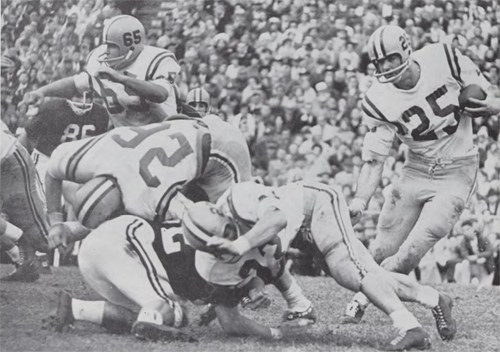
Billy Masters runs behind blocking of Danny LeBlanc (26), Labruzzo (22), and Aaron (65).
(LSU Gumbo Yearbook, Class of 1966)
Williams said after the game, "They were double teaming me most of the time in the first half. And when they weren't, that big tackle, McCormick, would just stand up, and I couldn't see what was going on."
Labruzzo Puts LSU Back in Front
Arkansas suffered a setback one play after the kickoff when Brittenum left the field with a shoulder stinger after throwing a block. On third down, backup QB Ron South fumbled a handoff, and LB Bill Bass recovered at the 34. Smelling blood, Screen went to the air, hitting Moreau for 13. Then the Tiger offense got monotonous again. Why mess with success? Labruzzo hit left tackle for three, then 12 more. His next plunge put the pigskin at the two. Arkansas was waiting for him on the next snap, stopping him at the one. When Joe took it again, he was hit twice but wiggled, twisted, dug his cleats in, and eventually crashed into the end zone on the 16th play of the drive. LSU 14 Arkansas 7 (0:18)
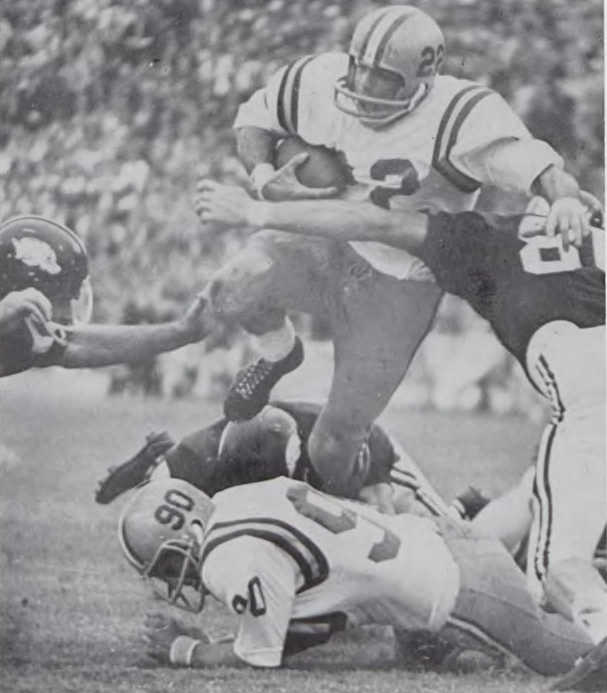
Labruzzo scores his second touchdown to put LSU ahead.
(LSU Gumbo Yearbook, Class of 1966)
LSU assistant coach Doug Hamley said he never experienced anything like what happened at halftime. "We couldn't hold the team in the dressing room. They got up four times and tried to leave, but Coach McClendon had to hold them back because the bands were still on the field."
A light drizzle started during halftime and continued intermittently the rest of the game. Brittenum returned for the second half but not Stokley.
Tigers Repel Threat
After punting to the two, Arkansas got the ball back at the LSU 49. Intent on tying the score, the Razorbacks slashed to the LSU 15. On the next play, speedy Jim Lindsey took a deep pitchout and raced laterally across the field. LSU's defensive end on that side, Ernie Maggiore, was being blocked but as he went down, he spun his body around and threw his legs across Lindsey's path, tripping him for a 6y loss. Brittenum slipped down at the 28 on second down and then missed on a pass. So South tried a field goal from the 36 that fell short.

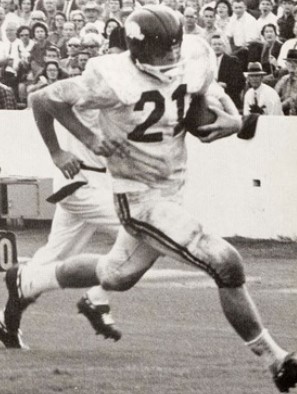
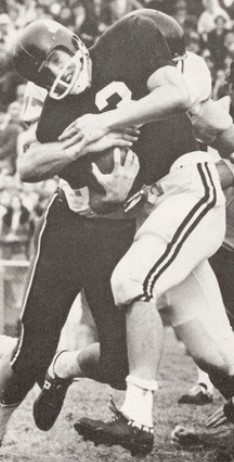
L-R: Jon Brittenum, Jim Lindsey, Bobby Burnett
(University of Arkansas Razorback Yearbook Class of 1966)
Arkansas' halftime adjustments thwarted the Tiger running game for most of the second half. As Williams explained, "I started stunting more to the right and the left after the half, and we stopped them more." LSU gained field position when the teams traded punts the rest of the period. Nix's effort traveled just 19y to the LSU 46. The third quarter ended with no Tiger first downs and no points for either team. LSU 14 Arkansas 7
LSU got the running game back in gear. With Dousay hacking away for short yardage, the Bengals moved relentlessly to the two before facing fourth-and-goal. Moreau was asked to convert a chip-shot field goal from the nine to put the Tigers two scores ahead. But the holder of the 1964 national record with 14 field goals missed it. Doug said afterward, "No excuses. The angle wasn't particularly hard. Nervousness didn't have anything to do with it."
Joseph INT Thwarts Hogs
Given new life, the Razorbacks started moving again. Brittenum fired passes to Crockett for eight, 16, and 18y–three of his Cotton Bowl-record ten receptions during the afternoon. Following Bobby Burnett's 18y blast up the middle to the LSU 36, Jon tried another bomb to Crockett, but CB Joseph, who had been the target of the previous completions, intercepted at the 20 with 4:39 left on the clock.
Jerry said afterward that the Tigers shifted from a man-to-man pass defense to half man-to-man and half zone in the second half to contain Crockett. "He'd been going wide on me. I decided the next time he came down wide, I was going to cut in front of him. He did, and I cut in front … All of a sudden, there was the ball, and I caught it."
The Tigers ate up almost two minutes before having to punt. Brown boomed a 49-yarder to the 11. The Razorbacks didn't go down easily. Brittenum filled the air with passes in a last gasp drive that carried to the LSU 24 before time ran out.
FINAL SCORE: LSU 14 ARKANSAS 7
Joe Labruzzo, who carried the ball 21 times for 69y, won the Outstanding Back Award, and Dave McCormack took home the Outstanding Lineman Award.
Postgame
When the Tigers reached their locker room, they shredded a red jersey bearing No. 23. Coach Mac, standing on a trunk to be heard over the jubilation, told them, "The rest of your lives, you won't ever forget what you did today."
Talking to the press, he proclaimed the victory his greatest thrill since his playing days at Kentucky when the Wildcats snapped Oklahoma's 32-game winning streak in the 1951 Sugar Bowl. "Fellas, we beat a good football team. … We slowed them down and made them play our type of game. I told you writers before the game that we couldn't match their speed, and we couldn't. But we played control ball and came up with the big play. Our kids followed instructions right to the end. … We didn't have a fumble or pass interception. There were times when it looked like we should pass, but we weren't going to put the ball into the air and give them the chance for that interception. They'll kill you. … I just told Pat Screen before the game, 'Let's go after them with everything we've got.' He said, 'Coach, I think I'm ready.'"
Dejected Arkansas coach Frank Broyles had little to say. "It hurts. They just beat us. … I thought we had a chance until that interception. … We knew LSU could run good, and they did. They hurt us on key downs passing, and they blocked real good. … That Labruzzo is a real good runner. He and the entire LSU team are to be congratulated."
Years later, the College Football Hall of Fame coach recalled the '66 Cotton Bowl as "the sickest I've ever been in coaching."
Reference
LSU Bowl Games: A Complete History, Neal Golden (2021)
LSU Bowl Games: A Complete History, Neal Golden (2021)